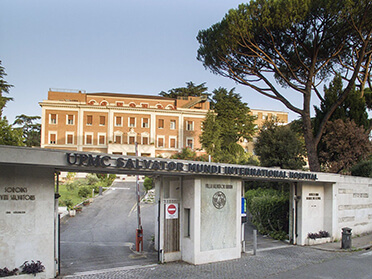Functional, Cosmetic and Plastic Gynecologic Surgery
The Functional, Cosmetic and Plastic Gynecologic Surgery service at UPMC Salvator Mundi International Hospital offers a comprehensive and personalized approach aimed at meeting the specific needs of each patient.
A Combined Approach to Women's Health
The synergy between functional gynecologic surgery and cosmetic and/or plastic gynecologic surgery represents a significant breakthrough for women's well-being and health. The goals of this method are:
- Treat disorders resulting from the natural aging of the genito-urinary system, such as prolapse, urinary incontinence and vaginal dryness.
- Improve the cosmetic appearance of the genitals without surgery but using vaginal laser therapy and fractional radiofrequency.
Pathologies and Disorders Treated
- Childbirth scars and puerperium uro-gynecological dysfunction.
- Dyspareunia.
- Genital prolapse.
- Genito-urinary syndrome in menopause.
- Lichen sclero-atrophicus and vulvodynia.
- Urge or stress urinary incontinence.
- Uterine fibroids.
- Vaginal atrophy and dryness.
- Vaginal relaxation with loss of tone and sensitivity.
- Vulvar imperfections of the labia minora and labia majora.
- "Wide vagina" with rectocele.
Our Services
The personalized diagnostic therapeutic care pathway (PDTA) begins with counseling with the gynecologic specialist. The latter makes use of modern instruments for painless vaginal laser therapy, fraxi-radiofrequency. When necessary, your specialist may use the latest techniques of vaginal and laparoscopic pelvic reconstructive surgery.
The pathway also includes physiotherapists experienced in pelvic floor treatment to treat both postpartum women and menopausal patients dealing with urinary incontinence, uterine prolapse, rectocele or uterine fibroids.
Our services include:
- Clitoridoplasty.
- G-spot enhancement.
- Hymenoplasty.
- Labioplasty of the labia minora.
- Lipofilling of the labia majora.
- Liposculpture of the Mount of Venus.
- Minimally invasive removal of uterine fibroids with uterine preservation.
- Perineoplasty with rectopexy.
- Precision medicine from microbiota metagenomics.
- Vaginoplasty.
- Vaginal and laparoscopic genital prolapse surgery.
Treatment may vary depending on the specific needs of each individual patient. Consultation with the gynecologic specialist will identify a customized multidisciplinary diagnostic therapeutic care pathway to achieve the best result quickly.
Clitoridoplasty
Clitoridoplasty is a procedure recommended especially for postmenopausal women, especially when the clitoris is buried by prepuce adhesions resulting from dystrophic processes, causing inflammation. Other situations requiring this surgery may be anatomical dysmorphisms or genital mutilation.
G-spot Enhancement
G-spot enhancement is a safe and painless procedure to enhance the volume and improve the perception of the Gräfenberg point (G-spot). This procedure, performed on an outpatient surgical basis with local anesthesia, uses a combination of radiofrequency to stimulate circulation and regenerate nerves, along with the application of PRP or mesenchymal stem cells.
Hymenoplasty
Hymenoplasty is a surgical procedure involving the anatomical reconstruction of the hymen. This procedure, performed in a same-day setting, aims to restore the hymen using the residual rim. The surgery is gentle and, within a few weeks, leaves no obvious marks, allowing the restoration of a new "virginal" hymen condition.
Labioplasty
Labiaplasty is a procedure aimed at correcting any problems related to the genital labia minora. When these are excessively prominent, irregular, or have hyperpigmentation on the outside, it is possible for them to cause discomfort such as irritation or pain during sexual intercourse. In cases where they are dysmorphic or asymmetrical, they may also affect urination or cause pain during intercourse, thus altering the quality of the sexual experience.
The surgical procedure has two main steps: the first is clitoral hydro dissection, which gently separates the adhesions covering the clitoris; the second step is V reverse plastic, aimed at restoring the normal anatomy and function of the clitoris. This surgery aims to mitigate inflammatory episodes and improve the patient's quality of life.
Lipofilling
Adipose tissue is truly a versatile filler: it blends naturally with the body, being autologous and fully compatible. It is rich in various cells, including adipose tissue-derived stem cells (ASCs), which are essential for regenerative and tissue repair treatments.
With lipofilling, adipose tissue is transferred along with adipocyte stem cells for several goals: increasing volume, restructuring, and regenerating skin and subcutaneous tissue, and treating damaged or hypotrophic areas. This method offers two customized approaches to improve tissue quality, adapting to the specific needs of patients:
- In the case of genital Lichen Sclerosus, lipofilling can regenerate vulvar tissues affected by this condition, reducing scar fibrosis. The procedure involves liposuction followed by infiltration of the tissue into the vulva, promoting the disappearance of skin ulcerations and improving skin elasticity and hydration.
- Regarding female genital rejuvenation, by harvesting adipose tissue from other areas of the body such as the abdomen or thighs, it is possible to reshape and revitalize the labia majora, the Mount of Venus, and scar retractions from episiotomies during childbirth. Lipofilling restores volume and shape while also stimulating skin regeneration through stem cells, visibly improving the appearance and tone.
Minimally Invasive Removal of Uterine Fibroids with Uterine Preservation
The technique of minimally invasive removal of uterine fibroids with uterine preservation represents a revolutionary approach. Beyond its importance for fertility and pregnancy, the uterus plays a crucial role in maintaining pelvic statics, serving as a hub for many anatomical structures.
Our methodology focuses on preserving the organ, preserving the integrity of the pelvic floor and significantly reducing the risk of vaginal dome prolapse and related urinary disorders. This innovative technique allows even large fibroids to be removed without resorting to hysterectomy, providing women with a safe and effective solution that preserves their pelvic health and overall well-being.
Perineoplasty
Perineoplasty addresses excessive relaxation of the perineum, often resulting from an incomplete muscle tear during childbirth. This minimally invasive surgery is recommended when functional problems in defecation occur due to a grade II/III anterior rectocele. Rectocele, which causes widening of the vaginal introitus, can affect the quality of sexual experience and generate dissatisfaction in the couple, characterized by a feeling of a "wide and relaxed vagina."
Often associated with vaginoplasty, perineoplasty aims to improve both cosmetic appearance and function. It corrects the defect in Denonvilliers' fascia, thereby restoring the normal anatomy and function of the vagina and rectum. This not only improves sexual satisfaction through a return to normal vaginal habitability, but also resolves issues related to defecation.
Vaginoplasty
Vaginoplasty aims to correct stretching and relaxation of the vaginal muscles. This procedure restores function to the pelvic viscera, restoring depth, elasticity, and habitability to the vaginal canal that may have been compromised after childbirth or surgery.
There are several types of vaginoplasty:
- Shrinking and reshaping, to restore tissue tone and firmness.
- Widening, useful in cases of postatrophic stenosis of the vagina and vaginal introitus, such as "Z" widening plastic involving transposition flaps.

We offer medical services and services on a private basis or in agreement with the main insurance companies. Some of our services are also affiliated with the National Health System.
For more information on active agreements, visit:

